Triggers - Recalls
- Get Started
- Release Notes
- Automations
- Patient Channel
- Troubleshooting and FAQ
- Patient Facesheet
- Technical Specifications
- Insights & Analytics
- Collaborative Inbox
- Conversation Flows
- Campaigns
- Lines & Resources Requests
- Lines, Events, Resources
- SMS Basics
- Triggers
- Referrals
- Add-Ons
- Users and Groups
- Platform Settings and Configuration
- Self-Rescheduling
- Recalls
- Marketplace
- Pulse Outreach
Table of Contents
Create a new Recall Trigger Configure Artera Practices Configure FiltersReview FiltersConfigure Trigger MessagingSet Recall Trigger TimingReview TriggerManaging TriggerFAQsAs an Enterprise User, you can configure Recall Triggers (automated messages) that can be used across your Practices. This functionality allows you to set a standard for your organization, controlling both message timing and brand voice.
Create a New Recall Trigger
-
From the Navigation Bar, select Automations > Triggers.
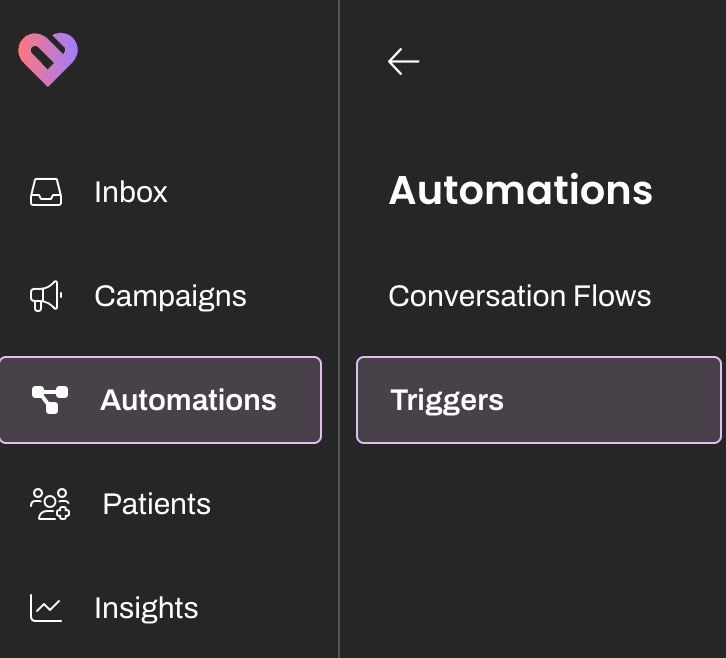
-
Select Create New in the top-right corner.
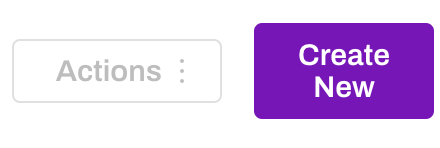
-
Add a Trigger Name. This will serve as the Trigger's title, so be sure to use consistent naming conventions. Next, select Recall from the Trigger Module drop-down and determine which Resource this Trigger should be sent from. Resource types are Provider, Location, Device, and General. Many customers send by Location Resource. Make sure the Resource(s) are connected with a Line. If you choose a Resource that has not been added to a Line, the Trigger will not be sent. Tip: Not sure how your Lines are configured? Navigate to Practice Settings > Lines and review the Resources added to the Line.
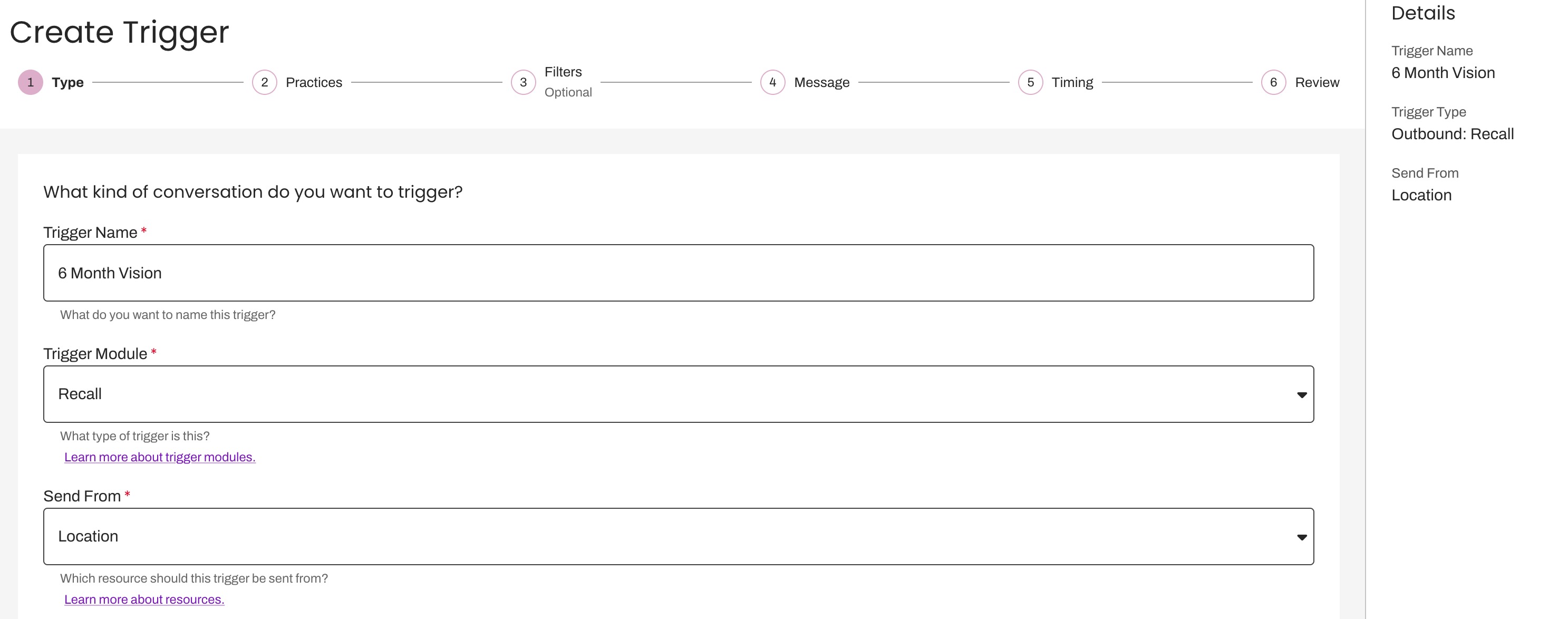
Note: As you progress through each step, the Details panel on the right-hand side will update with the Trigger's information.
Configure Artera Practices
Select the Practices that will send the Recall Trigger. Note: By default, all Practices will be auto-selected.
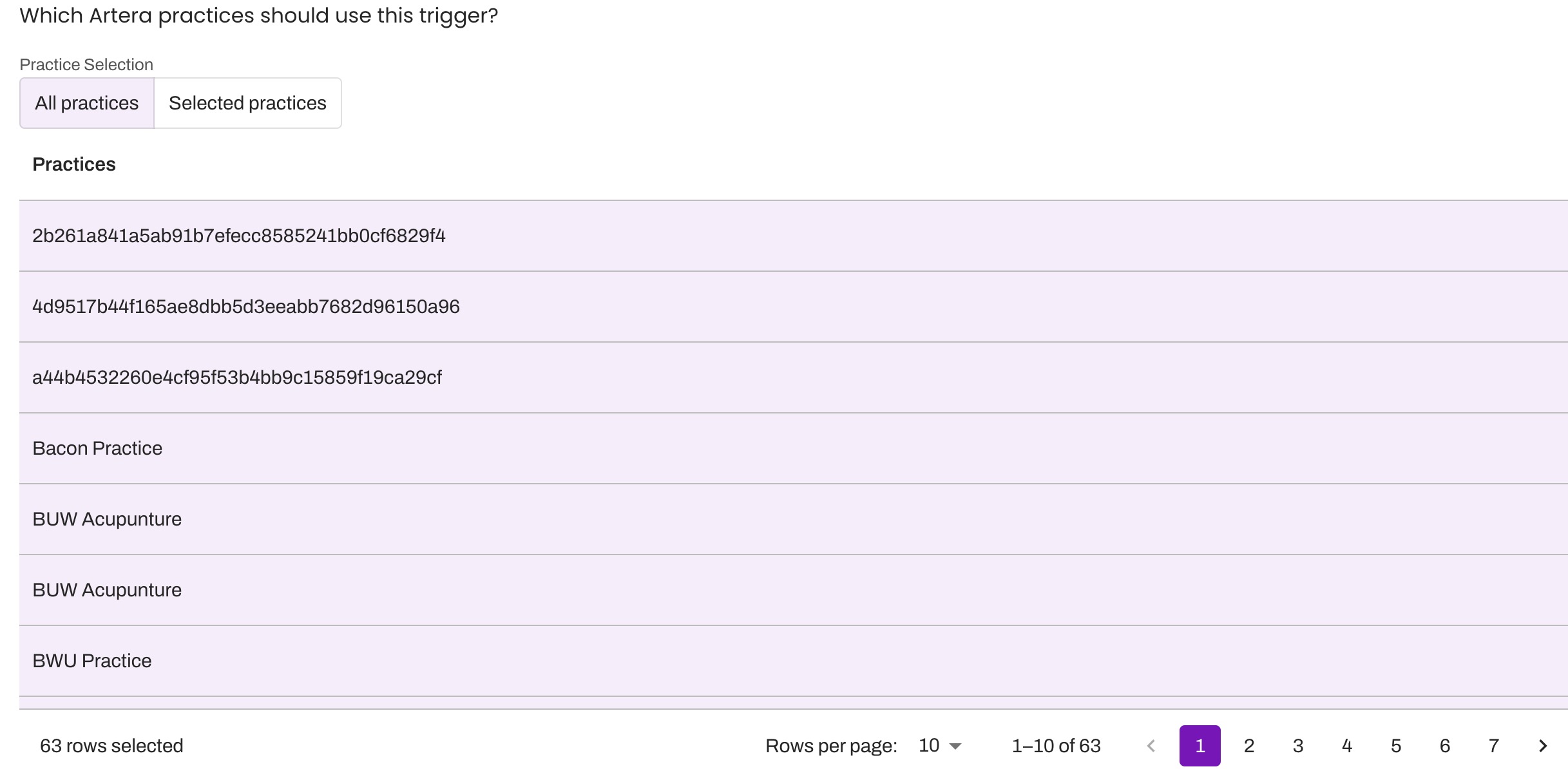
To locate specific Practices, click the Selected Practices tab and use the search bar to search by Practice name. Include Practices in the Trigger by using the check box near the appropriate Practice. Tip: Update the Rows per page up to 100 for larger Enterprises with many Practices.
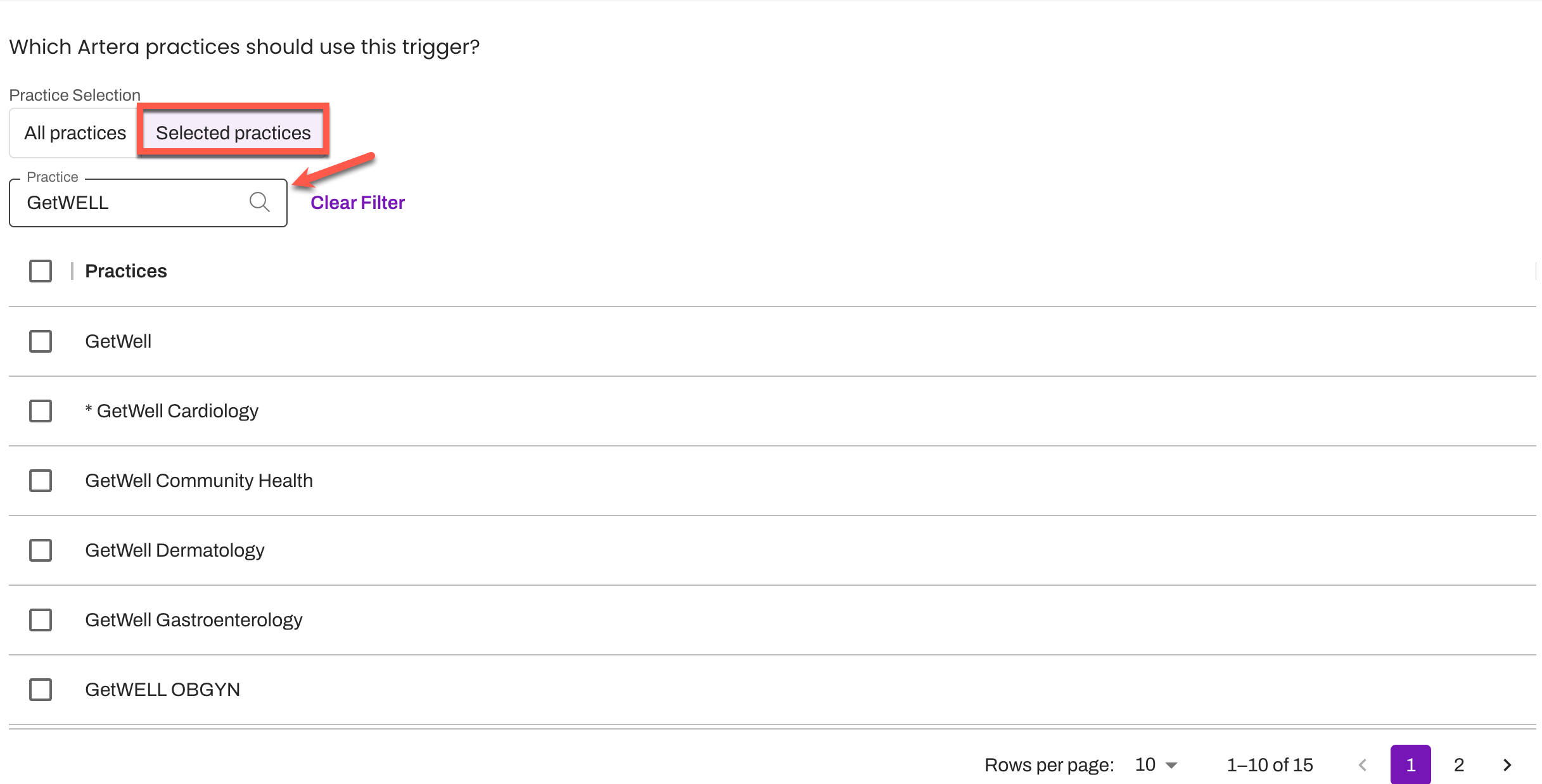
To bulk select your search results, use the check box located to the left of ‘Practices’.
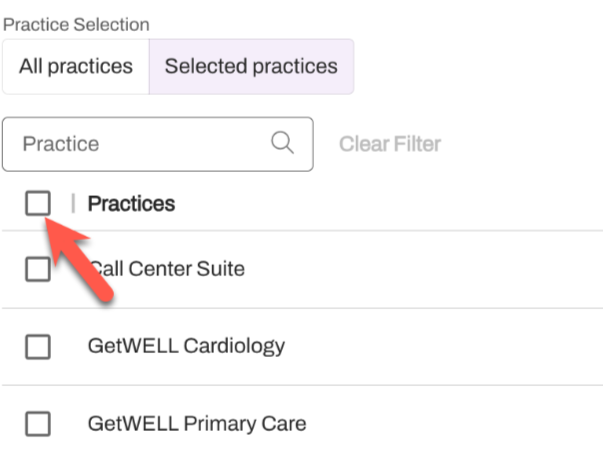
Configure Filters
Audience
-
Configure the Audience filters for the Trigger. This indicates the targeted patient population for the Recall Trigger.
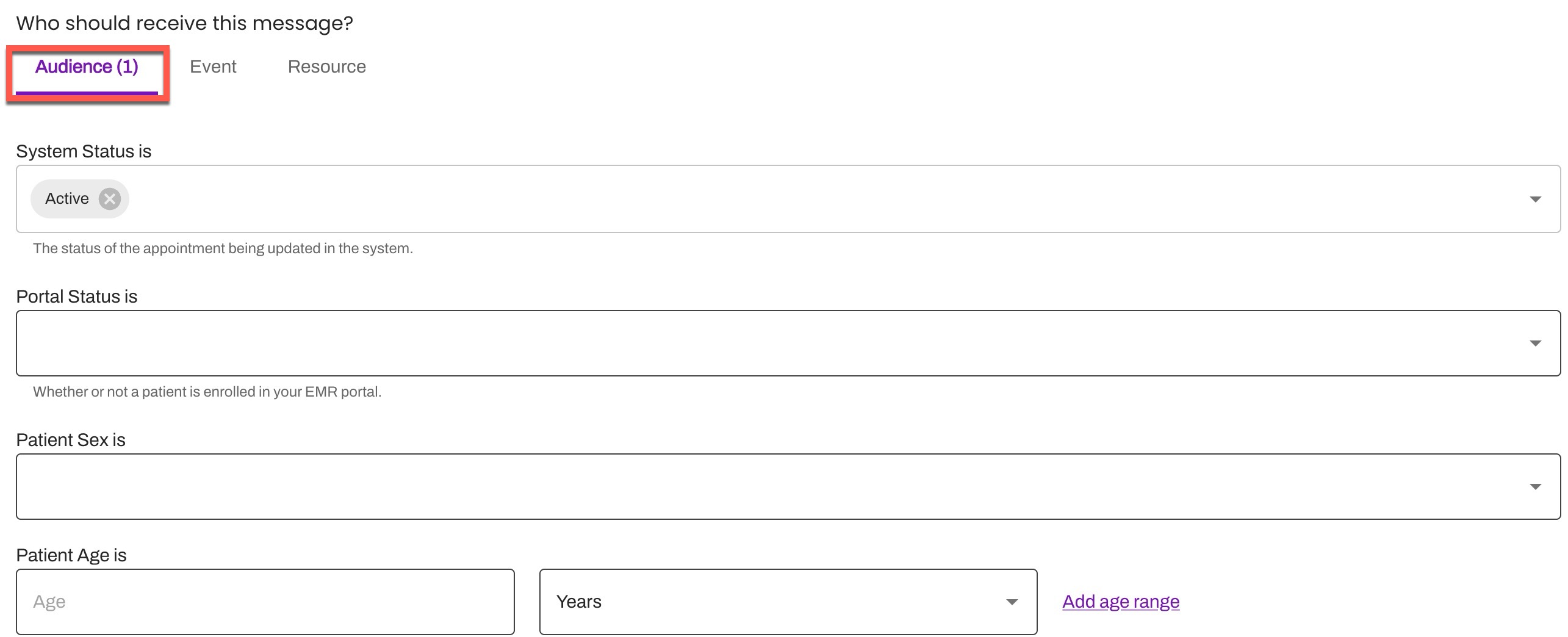
- System Status: These recall-specific statuses are system defaults that have been mapped to the corresponding statuses in your system of record (Active, Completed, etc.)
- Portal Status: These statuses indicate whether or not the patient is enrolled in your Patient Portal. Portal information is set up during implementation and not all EMRs support sending this data.
- Patient Sex: Segment your patient population based on Sex. You can choose a single option for this filter: Male, Female, or Unknown (where Sex is not included or has been omitted).
- Patient Age: Use this filter to include the age of the patient as a restriction. This can be a specified value or an age range.
Event
-
Navigate to the Event tab and select the Events eligible for this Trigger. Note: By default, all Events will automatically be selected.

-
To locate specific Events across all of your Artera Practices, click the Selected recalls tab and use the search bar to search for Recalls.
- Recall: This is the name of the Recall
- External ID: This External ID matches the Recall ID from your EMR
-
Practice: This is the Practice where the Recall is located
-
Use the search bar to locate your Recalls. Include Recalls by using the check box next to each Recall.

- To bulk select your Recall search results, use the checkbox located next to Recall.
- To maximize your view, use the Expand icon and a new window will open.
-
Use the search bar to locate your Recalls. Include Recalls by using the check box next to each Recall.
-
Determine if the Recalls selected should follow inclusionary logic by selecting Include or exclusionary logic by selecting Exclude. In some instances, it may be easier to exclude the Recalls or Resources that you do not want to send a Trigger to rather than to include all the ones you do.
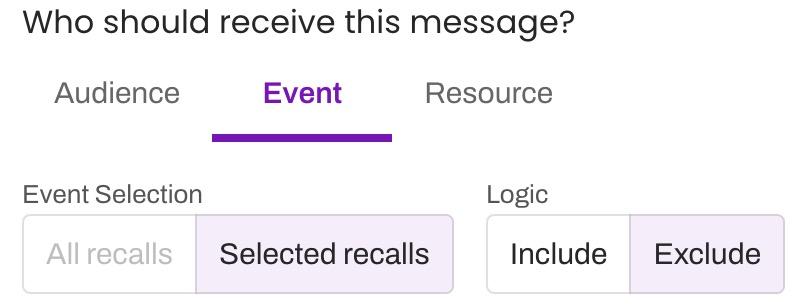
-
To locate specific Events across all of your Artera Practices, click the Selected recalls tab and use the search bar to search for Recalls.
Resource
-
Navigate to the Resource tab and select the Resource filters eligible for this Trigger.

-
Provider: Use the drop-down menu or manually type to locate specific Providers across all of your Artera Practices. Include Providers by using the checkbox near the appropriate Provider. To bulk select Providers, check Select search results.
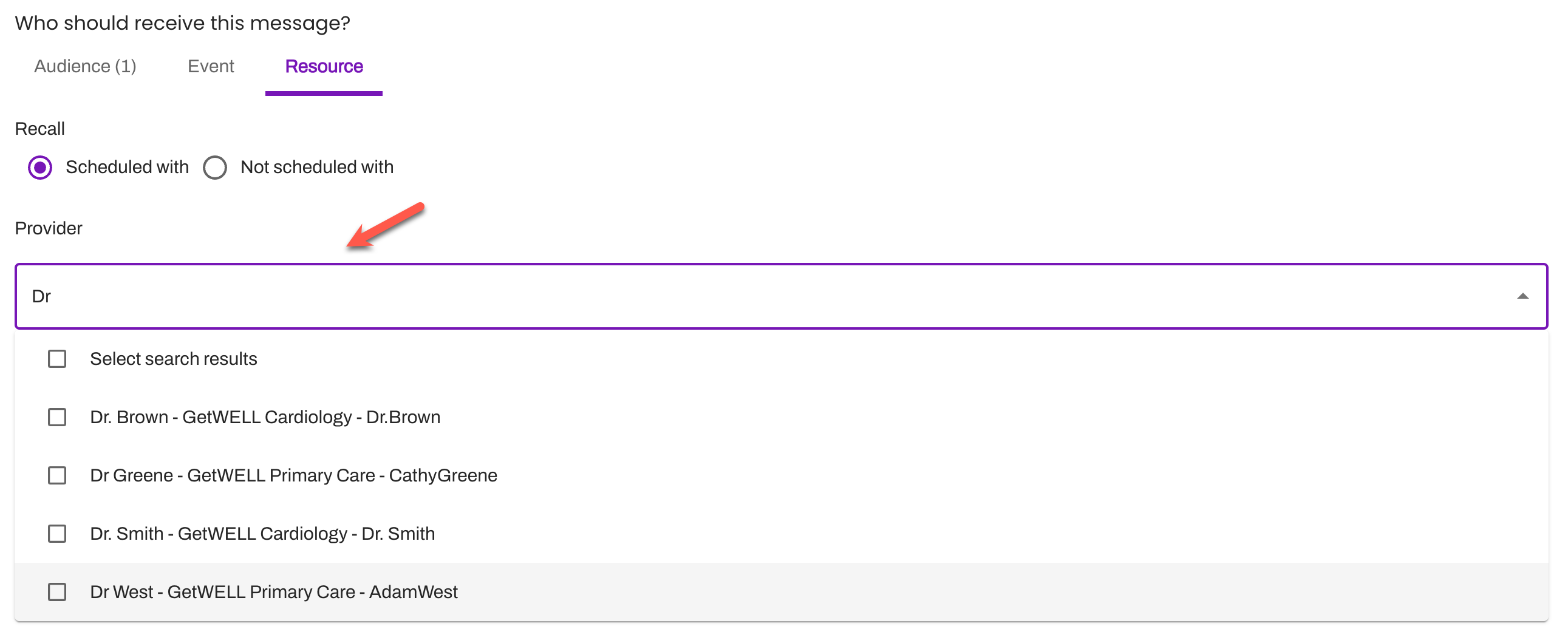
- Location: Use the drop-down menu or manually type to locate specific Locations mapped to your Artera Practices. Include Locations by using the checkbox. To bulk select Locations, check Select search results.
- Determine if the Resources selected should follow inclusionary logic by selecting the radio button Scheduled with or exclusionary logic by selecting Not scheduled with. Click here to learn more about Restriction Statements.
-
Provider: Use the drop-down menu or manually type to locate specific Providers across all of your Artera Practices. Include Providers by using the checkbox near the appropriate Provider. To bulk select Providers, check Select search results.
Review Filters
Before you proceed to the next step, review your selected Filters. Do note that if you selected any Practice that does not contain the Event(s) and/or Resource(s) applied when filtering, that Practice's patients will still receive the Trigger's message as Practices override Filters. This could result in patient confusion. Be sure to only select Practices where the Event and Resource filters applied exist. To prevent patients from receiving an incorrect Trigger, remove any selected Practice(s) that do not have these Events and/or Resources.
To identify which Practices should be included:
- Review the Details side panel and select the 'Include #' hyperlink beneath Event Filters and/or Resource Filters.

-
The Practice(s) those items exist in will display in a bulleted list. The order of information displayed in a bullet is: Event or Resource Filter name, Practice name, Event or Resource External ID.
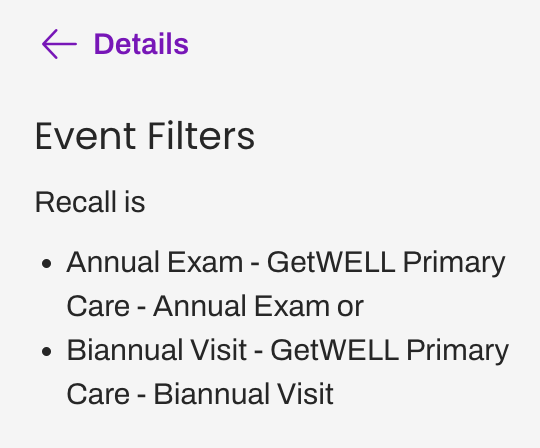 NOTE: If there are 100 or more Filters applied to a Trigger, the Details side panel will not display a complete list of Practices that include those items.
NOTE: If there are 100 or more Filters applied to a Trigger, the Details side panel will not display a complete list of Practices that include those items..png)
Configure Trigger Messaging
Next, you will enter the Recall Trigger's message for each of the content types you will support. Available content includes Text, Call, and Email. Messages can be customized for delivery method.
We recommend keeping text content short to optimize the patient experience. Emails can be longer and require a subject line. Voice calls should be configured to be more conversational. When a patient receives an automated phone call, they must answer with "Hello" or another greeting to prompt the message to begin. NOTE: Artera uses answering machine detection to listen to the answered greeting of the call and determine whether or not to deliver the message as a voicemail. For more information, click here.
Text messages must be under 1,600 characters, otherwise, the message will fail to send to the patient. You can check this by ensuring the denominator of the fraction of the character count in the bottom right corner of the message is equal to 10 or less. Learn more about SMS Character Limits and Message Formatting Guidelines.
You can choose to send Recall Triggers by a single delivery method or you can configure these Triggers to be sent via all three delivery methods to increase deliverability. If you select multiple delivery methods for your Trigger, the patient will never receive all three. How the patient receives the message is based on their Patient Communication Settings. Click here for a deep dive into crafting a message to support multiple languages, adding Attachments and or Forms, as needed. Tip: Check out our recommended message scripts in the Recall Automations Overview and Leading Practices article.
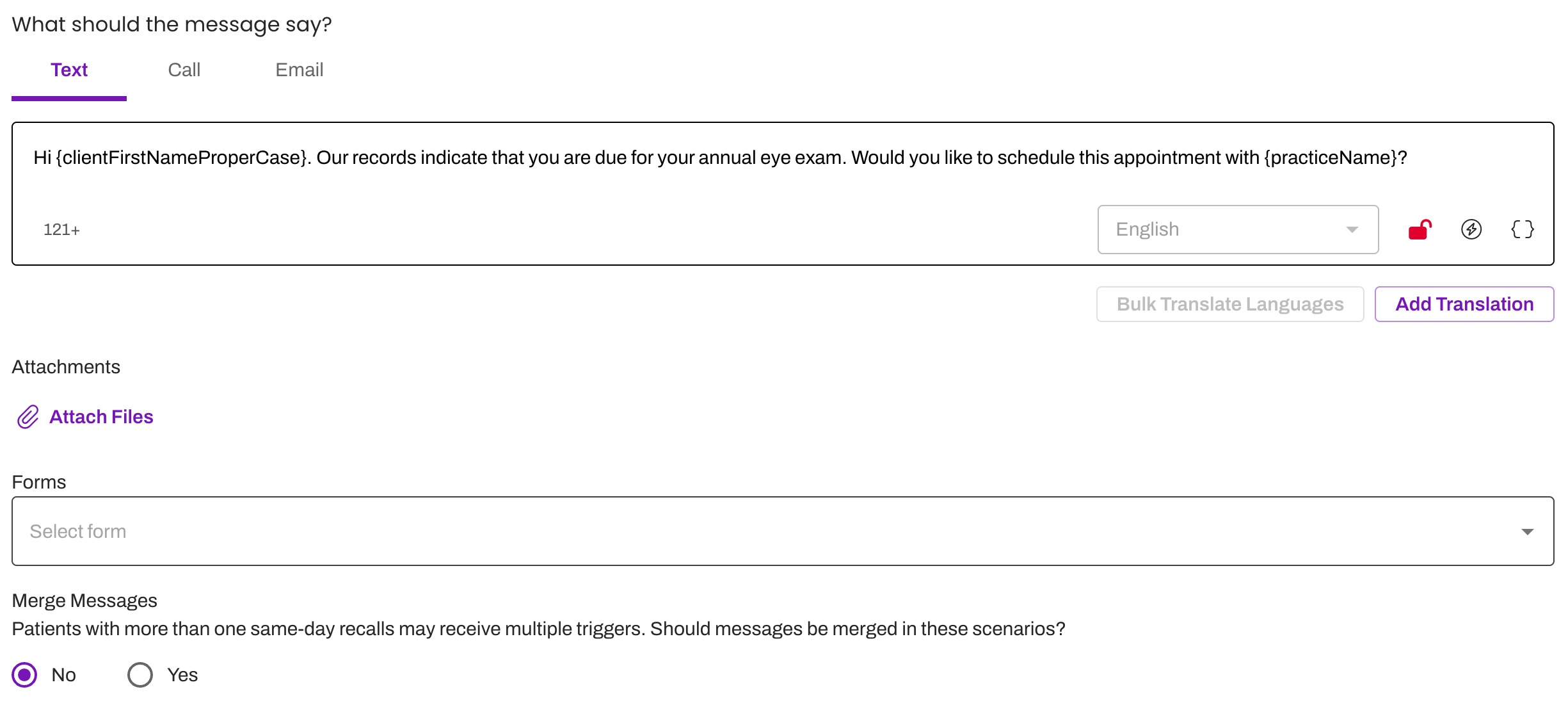
Quick Responses
Save time crafting your Recall Trigger's message by leveraging your Enterprise's existing Default-level Quick Responses.
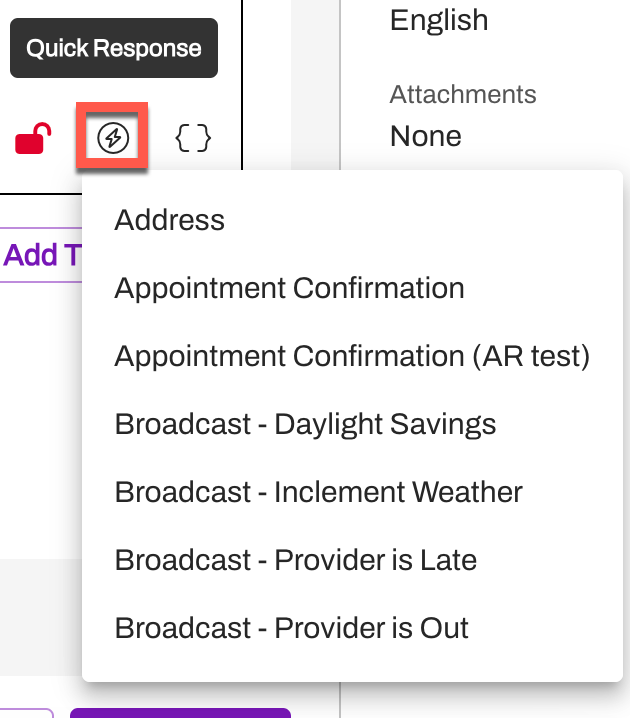
Merge Messages
Determine if you would like to merge similar messages for patients with multiple Recalls on the same day. Click here to learn more about Merged Messages.
Configuring Merged Messaging
To set up Merge Messaging for the Trigger, use the radio button to select Yes. A new template box will appear, allowing you to enter the Merged Message copy.
Note: If your Trigger is set up for multiple delivery methods, you will need to create a Merged Message copy for each delivery method before continuing to the next step.
Note: If you translated the original Trigger message into multiple languages, you will only have the ability to create a Merged Message in those specific languages. If you'd like to include additional translations to a Merged Message, you must first include an additional translation to your original Trigger message.

Merge Messages Considerations
You cannot merge multiple distinct Trigger. For instance, if one Trigger is set up to send a reminder for Dr. Jacobson and a second Trigger sends reminders for Dr. Smith at a separate Practice, the patient would still receive two messages: one for Dr. Jacobson and one for Dr. Smith.
Triggers that are configured to send from different Lines can be merged as long as they are in the same Practice.
You cannot attach a Form to a Merged Message.
Merged Messages respect patients, not phone numbers. So, even if two patients that share a phone number have the same type of appointment on the same day, the messages will not be merged.
Set Recall Trigger Timing
Next, determine when the Recall Trigger should be sent to the patient (e.g. 2 Days after the Recall is created, 4 Hours After the system status change, etc.). Tip: Check out the available Recall Triggers and what they entail here.
For Recall Triggers, there are five message events (see below) and associated send rules. You can indicate a specific amount of time to offset the Recall Trigger for two of the six message events, Recall Time and Recall Created.
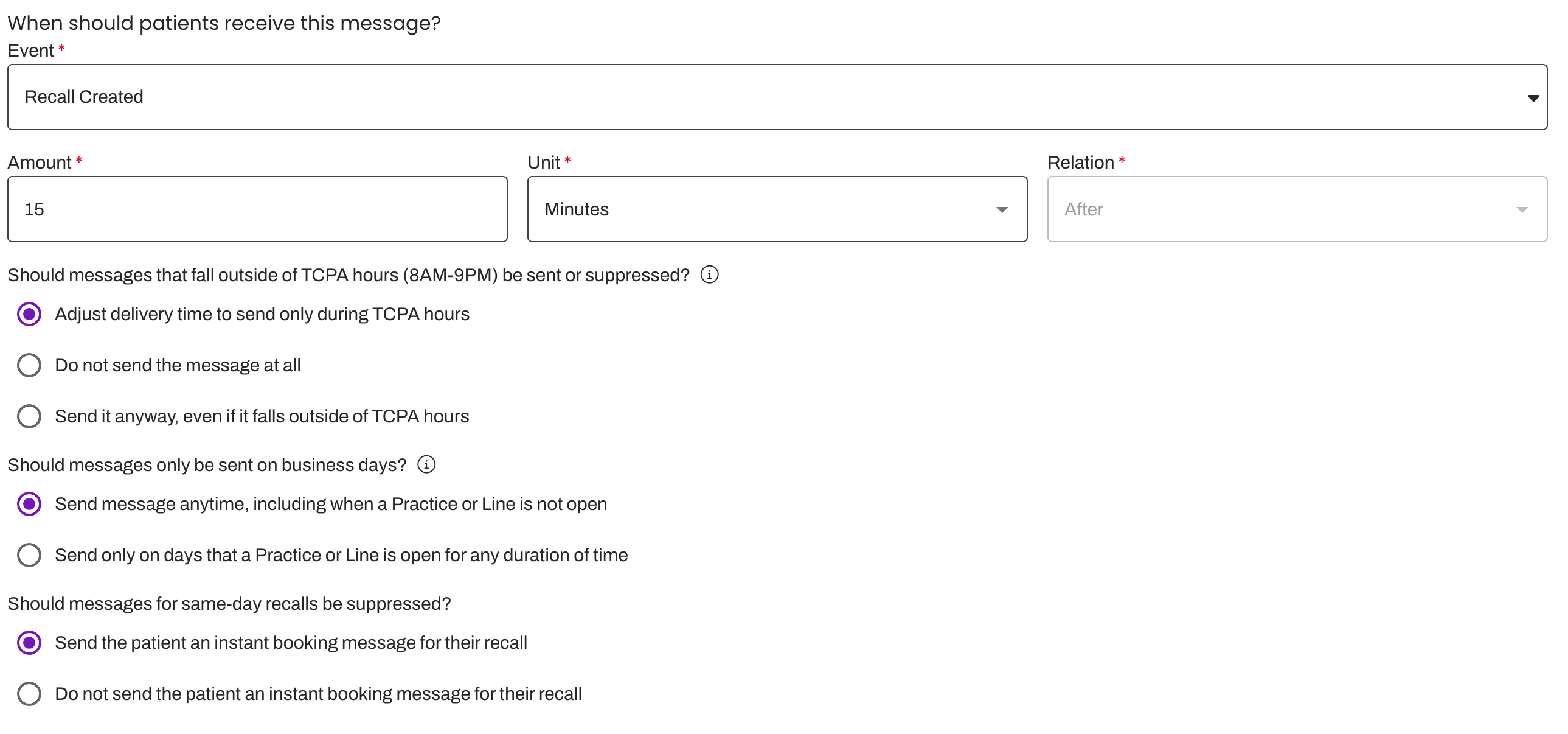
Recall Triggers
- Recall Time: Send the Recall Trigger based on when the Recall is 'due' (e.g. send 4 weeks before the Recall should occur for the patient).
- Recall Created: Send the Recall Trigger based on when the Practice created the Recall (e.g. send 15 minutes after Recall was created).
- System Status Change: Send the Recall Trigger based on when the status of the Recall has changed (e.g. send when Recall changes from Active to Cancelled).
- Date or Time Change: Send the Recall Trigger if the Date or Time of the Recall has been updated (e.g. Recall was 6 months, but now needs to be 3 months based on labs).
- Location Change: Send the Recall Trigger if the Location associated with the Recall changes (e.g. Recall was for a specific clinic, but clinic location closed).
Send Rules
Send Only on Business Days?
This rule is only available for Recall Time or Recall Created triggers. Note: This setting will be grayed out and cannot be enabled unless the automated Recall Trigger is set to send at least 15 minutes after the chosen message event.
Business Days are determined by your Practice and Line Hours. Any day that your Practice or Line is open for any duration of time counts as a Business Day in Artera.
Impact
If you restrict a Recall Trigger to send only on Business Days and the message is set up to send 1 Day Before the Recall is due, patients with Recalls that fall directly after the weekend will receive their message during your last business day.
For example, if your Practice is closed on Saturday and Sunday, reminders for Monday's Recalls will be sent the Friday before the Recall rather than on Sunday.
Note: In Practices set up for One-Way messaging, all days are Business Days, so this toggle does not impact your Recall Triggers.
System Status Change Ignores Business Hours
If you configure the Recall Trigger to occur upon the message events of System Status Change (e.g Active to Complete), the Recall Trigger will go out regardless of Business Hours. Instead, the timing of the message depends on when your system of record sends status updates to Artera.
Suppress Conversation for same-day appointments?
When using the Recall Created message trigger, you can choose to not send the patient an Instant Booking message for their Recall.

TCPA (Telephone Consumer Protection Act) Guidelines
Artera enables you to send or suppress automated reminders based on TCPA guidelines. Choose between sending the message immediately, scheduling the message within the TCPA guidelines, or not sending the message at all. Click here for a full breakdown of TCPA Hours and how it impacts messaging.

When configuring Recall Triggers, we typically recommend choosing to Adjust Delivery Time when available, which will respect TCPA hours.
Review Trigger
Review the details of the Recall Trigger, ensuring all of the information is correct. To make changes, use Back to navigate through the Trigger steps.
Tip: To review the Trigger in different languages, use the drop-down menu located under Message.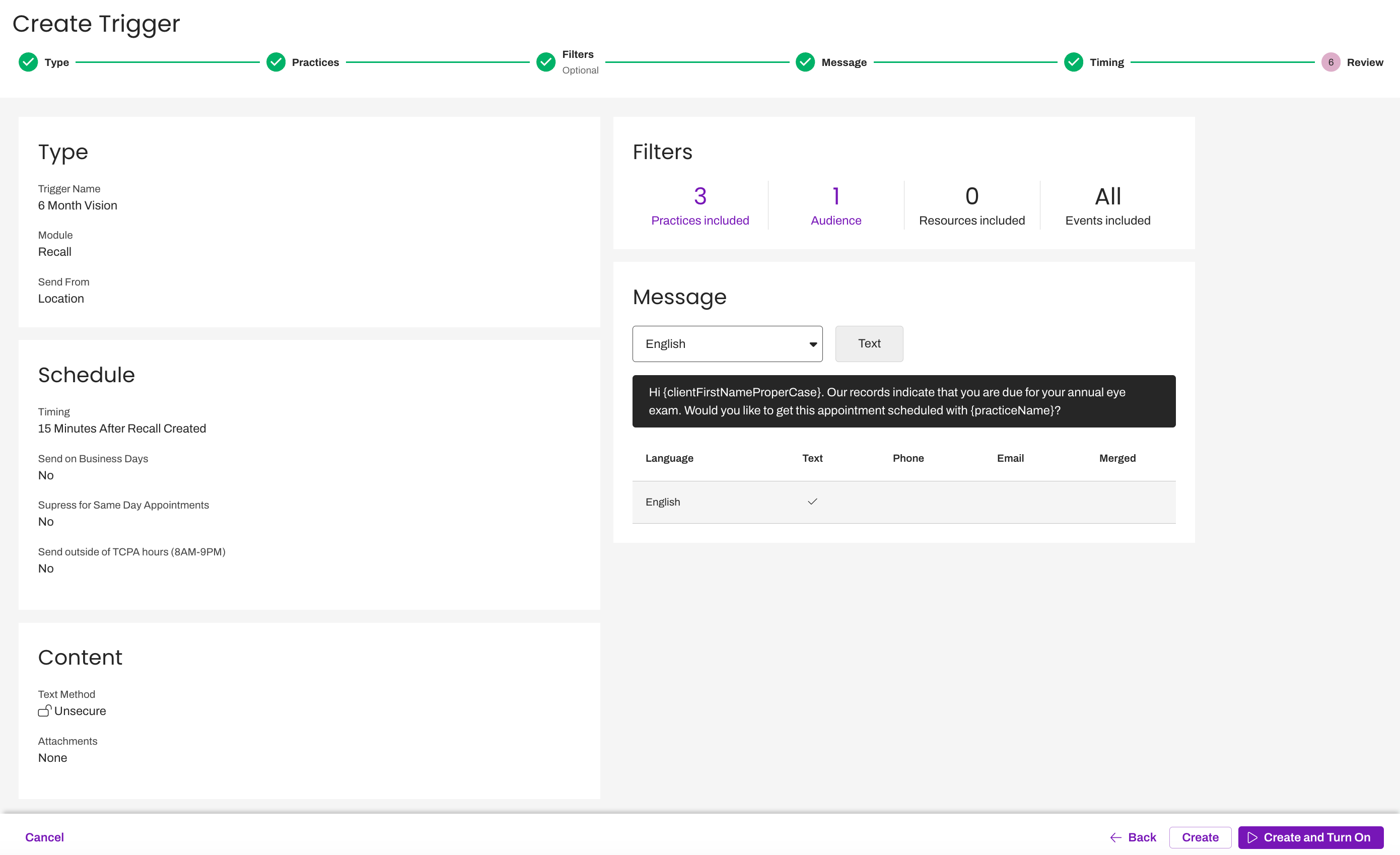
Click Create to finish creating the Recall Trigger or Create and Turn On to finish creating the Recall Trigger and allow it to start sending messages to patients.
Managing Trigger
It is important to have a Recall Trigger strategy to ensure that your Triggers stay up to date over time. Click here to learn more.
Editing a Trigger
As an Enterprise user, you can edit Recall Triggers so that the Triggers are updated for all Practices that use them:
Navigate to Triggers.
Select the Recall Trigger you wish to edit by clicking its three-dot Action menu on the right side and choose Edit.
Change desired section: Conversation Type, Conversation Content, Conversation Timing, or Conversation Aggregation.
Select Update when done to save your changes.
Creating Triggers From Template
You can create Triggers and then use them as a template for new Triggers that have similar functionality.
Go to the Actions menu of the Trigger you would like to copy by clicking the (...) Actions menu. Select Duplicate.
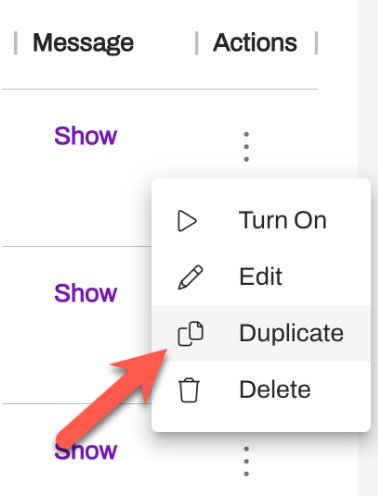
Edit the appropriate sections.
Once you have reviewed your Trigger, click Create or Create and Turn On.
FAQs
I created a Recall Trigger, do I need to navigate to the Practice-level to enable it?
All Triggers are now centrally located and managed through Triggers. You will no longer need to go to a Practice to build, configure, filter, and turn on a trigger.
What Time Offset Intervals can be used to configure Recall Triggers to send based on minutes?
Minutes offset can either be 0 or a minimum of 10 minutes. Then, you can offset the delivery of these messages in 5-minute increments. Recall Time and Recall Created can be configured with a time offset. However, for systems that complete a batch update once per day (typically overnight), we recommend avoiding 0-minute time offsets when building Triggers. By having a time offset of 10 or more minutes, you will be able to configure the Trigger to respect TPCA Hours and not send to the patient overnight when the batch file is received.
